Canadian no-tillers often complain their growing season is too short to add cover crops to their rotation or diversify their cash crops. But interest in intercropping appears to be budding as more growers find they can use the practice to extend the season, achieve more yield per acre, reduce input costs and better manage risk.
Joe Wecker, who farms at Sedley, Saskatchewan has realized all these benefits and has downsized his 11,000-acre farm to 9,000 acres after adopting intercropping, cover crops and other regenerative agriculture practices.
“We find we can do a better job with less land,” says Wecker, who was part of a producer panel at an intercropping workshop in Brandon, Manitoba last November that attracted around 140 people.
Goals Are Many
Each grower had a different reason for starting down the intercropping road. Brooks and Jen White operate a 6,800 acre, fifth-generation grain and bison farm, Borderline Agriculture, near Pierson, Manitoba.
More Tips for Intercropping Success
Intercropping involves seeding two or more crops together either side by side or in the same seed row.
The science behind intercropping suggests crops grown together have a synergistic relationship that encourages the exchange of nutrients between plants, takes advantage of spatial diversity such as different rooting depths and helps increase yields and prevent weeds, pests and disease.
Learn more about the science and economics of intercropping, and tips for separating intercrops by clicking here.
They’ve been serious zero-tillers since the early 1980s but had challenges with excess moisture. After a 5-year period where they only seeded an average of 40% of their cropland they realized something had to change.
After planting some mixed cover crops on their wettest fields as emergency feed, they noticed in the years that followed that these were the driest fields on the farm.
“We realized the water infiltration had improved due to the soil structure from the cover crops,” said White. “That was the moment that started us down our path of regeneration.”
The Whites live by five principles of soil health: no tillage, keep the soil covered, embrace plant diversity, maintain a living plant root and integrate livestock. And they say intercropping is the latest tool in their arsenal to get the most out of every acre. “The soil is alive and is our number one resource, so we want to work with nature and create an environment for us to grow healthy plants and nutrient dense food,” Brooks says.
Wecker, who grows 6,000 acres of organic and 3,000 acres of conventional crops on heavy clay soils, says the reason that he intercrops is to increase biodiversity for better soil and plant health.
“If you have biodiversity on top of the ground, you’re going to see the same biodiversity below ground with roots, microbes and other soil life,” he says. “You will increase beneficial insects, build mycorrhizae to improve nutrient exchange. It’s synergistic growth, not competition.”
Nick Cowan began seeding cover crops about 12 years ago, but 6 years ago also began intercropping, adding canola and peas and hairy vetch and rye.
No-Till Takeaways
- Peas and canola can work for those just starting to intercrop because it offers multiple benefits to soil and plant health and is easy to harvest and separate.
- Flax and lentils are better seeded in the same row because if separated the lentils can’t reach the flax to hold it up.
- Having a seeder that can place crops at different depths helps when soil moisture is a limiting factor as having the crops in optimal moisture improves emergence.
“Intercropping is a way to get our cover crops going,” says Cowan, who manages 10,000 grain acres, 600 cows and operates a 1,500 head feedlot near Hartney, Manitoba with his father, Bill and brother, Del. As an example, this year Nick planted sunflowers and buckwheat.
“We are going to combine the cash crop and just let the intercrop grow as cover crop,” Nick says. “We will probably turn the cows on that as well.”
Reducing Fertilizer Use
Many producers are using intercrops and other regenerative practices to increase soil and plant health and reduce inputs such as fertilizers and pesticides.
White is using full-season cover crop mixes, intercropping and year-round grazing to improve soil biological activity and reduce the need for added fertilizer.
“By adding a mycorrhizal companion we’re trying to eliminate the need for phosphate by adding a legume, as we are trying to extract nitrogen (N) from the air,” Brooks says. “We have reduced our commercial fertilizer bill to about 25% of what it was. Many fields are in a long-term transition phase to this plan, but intercropping is allowing us to reduce fertilizer inputs faster.”
Cowan says he uses no fertilizer at all on his intercrops. “This spring we applied Roundup, sowed the peas and canola and didn’t put a drop of fertilizer on and it worked out really well,” he said. “We just sprayed a half rate of Pursuit and a grass killer.”
Less Weeds, Pests
Growers intercropping are finding that weed pressure is less of a problem than it is in crops grown by themselves thanks to improved soil health and more ground cover.
“Nature is producing weeds to try to cover the bare soil to protect it, so we can grow plants in their place to address that issue,” says Brooks, who hasn’t had any weed issues in his intercrops so far.
White has also noticed lower insect and disease pressure. He can’t remember the last time he used insecticides and he hasn’t used fungicides for 3 years. While farmers in his area sprayed every field for aphids 2 years ago, White found very few in his canola and pea intercrops. This year cutworms were an issue and took out most of the canola in his faba bean/wheat/canola intercrop, but the wheat and faba beans compensated and filled the gaps.
Wecker says he hasn’t applied a fungicide in 5 years and has used intercrops to actually mitigate disease issues — for example with a three-way intercrop of peas, lentils and camelina.
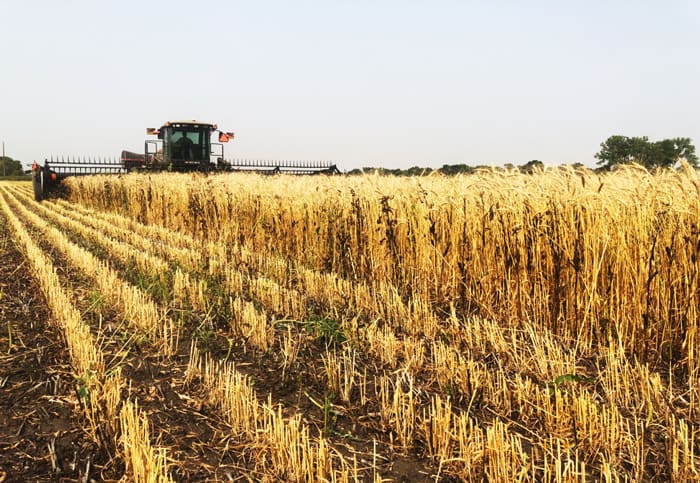
COLD CASH. An intercrop of faba beans, wheat and canola is swathed on the farm of Brooks and Jen White. Cutworms were an issue and took out most of the canola in this combination last year, but the wheat and faba beans compensated and filled the gaps, the family says, protections some of their income.
“I have root-rot issues in my peas every year, so the idea was if the peas didn’t do good I would still have lentil grain,” he says. It was a good strategy because his pea yield was low, but he had another 5 bushels per acre of lentils to compensate.
Nick says intercrops and cover crops have been huge for weed control.
“We don’t spray any grassy herbicides on our cereals,” he says. “We usually spray a cheap generic broadleaf in our wheat and annual ryegrass and perennial ryegrass. With our spring annuals we don’t spray a grass herbicide. Same with broadleaves — we’re cutting back. We just spray a grass killer on our sunflowers. With intercropping we’re seeing cleaner fields.”
Nick only sprays insecticides in an emergency and has also quit using fungicides because he says he simply doesn’t need them. “If we see a problem we’ll tweak our rotation the next year try and fix it that way or tweak our cover crops,” he says.
Adding intercropping to the overall farm-management plan has allowed the Whites to extend their growing season from the traditional frost-free window of mid-May to mid-September to the end of March through the end of October.
At the same time, they’re consistently seeing intercrops out-yield monocrops, adding significant value to the farm.
“In 2017, our pea and canola intercrop over-yielded both monocrop canola and peas and produced about $8 Cdn/acre more revenue than straight canola did, and the weather was extremely dry,” says Brooks. “Straight fertilized canola was the winner in our strip trials, but the interesting thing is peas and canola still out-yielded the peas and the straight canola with no fertilizer.”
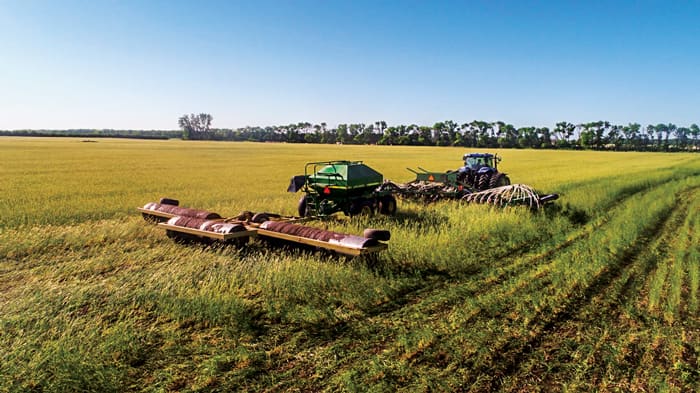
SEEDING MACHINE. The Whites use an older John Deere 1850 disc drill to seed a 23-species cover crop into rye/vetch stubble. They prefer to use the drill in high-residue situations such as with corn stubble. “I like the Deere for seeding cover crops and some of the intercrops that we know will work at the same seeding depth,” Brooks says.
Hairy vetch and corn is the Whites’ No. 1 intercrop from the perspective of adding the most value to the farm.
“For us to try and generate an income off of a relay crop like the vetch that’s in the corn and get a cash return of some kind in that year, we need a fence around it to graze it,” Brooks says. “To get a cover crop coming after rye or winter wheat is very possible in our area to try and capture some revenue back on it.”
He says this intercrop added about $40-$100 Cdn/acre value after the corn was harvested and the corn/hairy vetch residue was grazed said White. “It paid for our fence in one year,” he says.
Managing Risks
Proponents of intercropping systems say they spread risk because there’s always more than one crop growing, and chances are if one is affected by weather, insects or disease the other crops will compensate. So instead of a total loss there is usually something to harvest and provide a return on acres that might not have returned anything otherwise.
Brooks says his pea-and-canola intercrop has been hailed on twice and each time the crop that didn’t take the brunt of the hail gave him insurance he hadn’t expected.
“Last year at the time the hail came it pretty much wiped out the peas, but the canola filled in and took over,” he says. “We probably could have eliminated our hail insurance because the other crop compensated and gave us something.”
Intercrops are also helping Wecker to better manage through a lack of moisture.
“Every year, in certain parts of the field one crop is better than the other. And over the last two years I probably would have re-seeded 3,000 acres if I hadn’t had an intercrop there,” he said. “I always have a crop I can combine.”
Meeting Their Goals
All growers who are intercropping have their own combinations designed to meet specific goals, whether it’s increasing nutrient exchange through mycorrhizal activity, bumping up soil fertility, facilitating harvest, suppressing weeds or mitigating disease.
Since 2012, the Whites have grown peas and canola, canola/wheat/ faba beans, flax/lentils/clover, sunflower and clover, corn and vetch, corn and soybeans, and oats and peas.
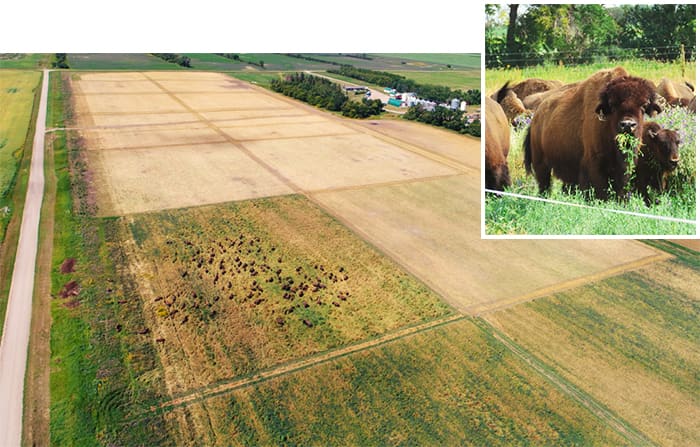
MANAGED BUFFET. The bison herd managed by the Whites intensively graze paddocks of full-season cover crops on their farm near Pierson, Manitoba. Their herd (inset) also grazes cover crops in temporary paddocks.
Peas and canola was the Whites’ first intercrop and they recommend it for anyone starting out with intercropping because it offers multiple benefits to soil and plant health, and they’re easy to harvest and separate.
“The interactions between the two plants form early on as the root exudates begin to feed soil biology,” Brooks says. “The peas provide a host plant for mycorrhizal fungi and N-fixing bacteria to thrive. This provides free nutrients for the canola. The canola, in turn acts, as a trellis for the peas to cling to and stay off the ground, making harvest much easier.
“These interactions set up a healthier environment in the soil for the following crop. They’re harvested as one crop, separated through a grain cleaner removing the dockage, which we’re using as feed for the bison and capturing extra value.”
The Whites have also intercropped flax and lentils, and they’ve added clover as a companion crop to get something else growing after the flax and lentils are harvested.
“We haven’t been growing flax and are missing it in our system because it’s a highly mycorrhizal plant host and we wanted more diversity,” he says. “Lentils is one of the best crops to put with flax because it’s another legume. We’ve been struggling to grow lentils, and flax acts as a trellis to keep them off the ground, which reduces disease because they aren’t wet underneath.”
One thing White has learned is that flax and lentils are better seeded in the same row because if separated the lentils cannot reach the flax to hold it up.
“We haven’t been growing flax and are missing it in our system because it’s a highly mycorrhizal plant host and we want more diversity” — Brooks White
Faba beans are proving to be a challenge to use as an intercrop. But White has tried several combinations because he’s concerned about the amount of pulses in his rotations and wants to integrate legumes like faba beans and soybeans to keep disease pressure low.
Faba beans with lentils didn’t work as the faba beans completely overtook the lentils and ended up as a monocrop. Faba beans with oats didn’t work either as the faba beans died. A triple intercrop of canola, wheat and faba beans looked more promising and Brooks hoped to benefit from several symbiotic relationships with these three crops.
“The grass was to hold the faba beans up and the canola was to attract bees and improve pollination for the faba beans,” says Brooks, who targeted seeding at two-thirds the faba bean rate, a quarter rate for both the wheat and canola, and added no fertility.
The crop looked good until a dry summer took out most of the faba beans, but the wheat compensated.
“With 23 pounds of wheat per acre being seeded it turned into an 80% wheat crop,” says Brooks. “Again, it was self-insuring and when the wheat took over we got something instead of my 10-acre monocrop faba bean crop, which was terrible.”
A personal favorite for White is oats and peas because it’s versatile. “We can graze it, hay it, combine it, separate it, feed it, so it provides lots of options,” he says. “It’s really clean and we haven’t used any herbicides on oats and peas yet.”
A successful intercrop for the Cowans this year was silage corn and Roundup Ready soybeans sown together. Corn was seeded at a regular rate of 32,000 plants an acre and long-season soybeans at 10 pounds per acre to produce extra nitrogen (N).
“I was worried the soybean planted at the same time would take away from the corn, but it didn’t. We had a great corn crop,” Nick Cowan says. “When we silaged the corn it was raining and the beans helped trackability so we didn’t make as many ruts. We only did this on 200 acres, but this year it’s going wall to wall. We’ll combine the corn and then turn the cows out on the stubble and the soybeans.”
Machines that Work
There isn’t a right or wrong way to seed intercrops, and it often comes down to trial and error. When Brooks bought a new SeedMaster air seeder it was with intercropping in mind.
“I knew intercrops were the direction we were going. We were having success with soybeans and using more corn for grazing, so we wanted to get one machine that would do everything on the farm,” he says.
The SeedMaster was ordered with the idea of seeding on either 15- or 30-inch rows and have the ability to seed alternating rows.
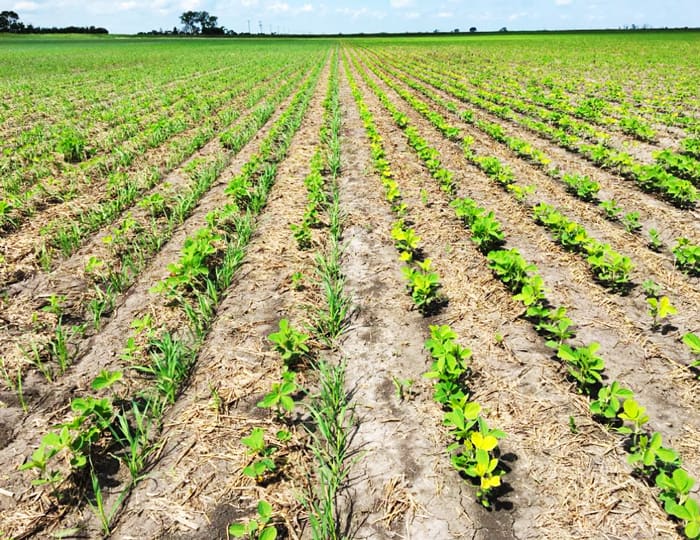
HEALTHIER BEANS. On the left is a soybean/oat intercrop and the right is a soybean monocrop on the White farm in Manitoba. Brooks says the intercrop system helped decrease issues with iron chlorosis deficiency in the soybeans when compared to the monocrop.
“I can run all the openers in the ground or I can turn a hydraulic valve so only half of them go down to allow 30-inch spacing,” Brooks says. “The rollers are made to accommodate this because of the on-frame tanks. They only drop seed into the cups that we want to distribute seeds to. We’re not pulling a tank with a central distribution system so this becomes easier.”
White also added a 24-row Valmar tank setup so each cup feeds two openers, then added a simple, homemade splitter attachment (a metal plate) and a ball valve on each opener so he can turn off the flow to any opener that he chooses.
The SeedMaster has 48 dual-chute openers spaced about 2 inches apart and normally one of the openers would be used to place fertilizer deeper to the side of the seed, which gives the Whites some flexibility to seed different crops at different depths.
“This works well when seeding something like faba beans and canola,” he says. “We can place the faba bean at a deeper depth than the canola. We’ve also seen this as a benefit in seeding peas and canola together. In ideal seeding conditions this is less of a concern, but if soil moisture is limiting it helps to seed each crop to the proper depth so you get more even emergence.”
The Whites also have an old John Deere 1850 disc drill which they prefer to use in high-residue situations such as with corn stubble. Or they’ve used a Shelbourne Reynolds stripper header. “I like the Deere for seeding cover crops and some of the intercrops that we know will work at the same seeding depth,” Brooks says.
“The disc drill has the ability to seed alternating rows from the way that we installed the primary hoses and the manifolds from the tank. The front rank can seed a different product than the back rank with simple plugs installed in the primary distribution manifold under the air tank.”
Nick has experimented with different ways of seeding intercrops and has settled on broadcasting his fertilizer and using his single-chute air drill to seed and “bang around the trash and let the fertility go down. If it’s too dry, we stop and try and fertilize right before a rainstorm and let the rain wash it down.”
Feeling Out Rates
Seeding rates for intercrops are not an exact science and a lot depends on the end goals, growers say.
“I just try something and learn from it and adjust next year, but conditions may favor the opposite crop another year and results may be different,” Brooks says. “It depends a lot on what you’re trying to accomplish with the intercrop as to which is the primary crop and which is a support crop.”
Brooks tries to use legumes as much as possible as a host for rhizobia bacteria and to avoid additional N application.
“In my peas and canola the peas are seeded at about two-thirds of what I would target a monocrop plant population, and then my canola would be about half the rate of my monocrop canola plant stand target,” he says. “I find this to be enough canola to aid in holding the peas up and provide enough canola to make separation worthwhile.”
When White seeds oats with forage peas he keeps the amount of peas fairly low in the stand because they can lodge and pull the cereal crop down. He’s only done corn and soybeans twice for early fall grazing and to gain both the benefit of improving nutrition to his bison and feeding the soil with the intercropped mix.
“I still used about a half-rate of fertilizer and the first time I alternated the rows and the second time I included them both in the 30-inch row as I was direct seeding into a perennial pasture and I didn't want to disturb any more of the sod then I had to,” Brooks says.
“I targeted a corn population of 20,000 and the soybeans at the same rate. I also added a few pounds of hairy vetch to the mix. The alternating row method I think worked better overall and I would like to do this again.”

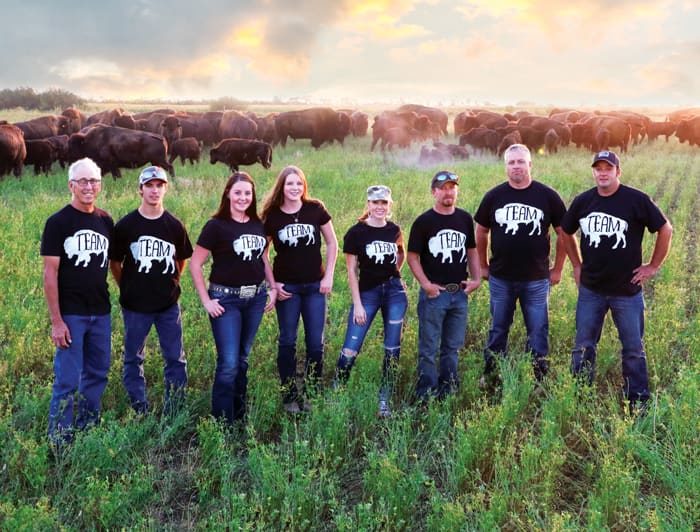





Post a comment
Report Abusive Comment